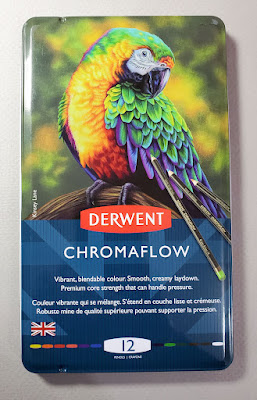 |
| I like the parrot. |
It’s always fun and exciting to open a fresh set of colored pencils and use them for the first time. I try to adjust my expectations based on a variety of factors – where they were manufactured, their price, the maker’s reputation, reviews by others, how they smell, how they look. Sometimes I have learned an intriguing fact about them – for example, a European manufacturer is distributing the set only in the US and not within its own country. How interesting! Bring ‘em on.
Although the basic set of 12 doesn’t include hues I would choose according to the CMYK-based primary triad I have been experimenting with, I still like using a primary triad to make initial sketches because it’s a good test of blending capability.
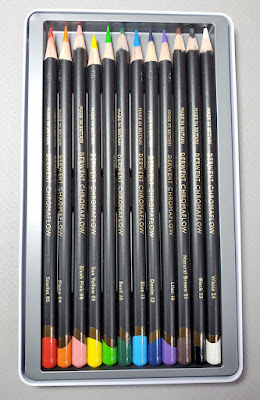 |
| The basic set of 12 colors |
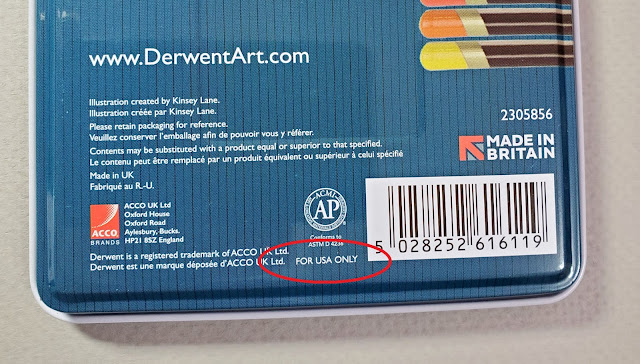 |
| For the USA market only |
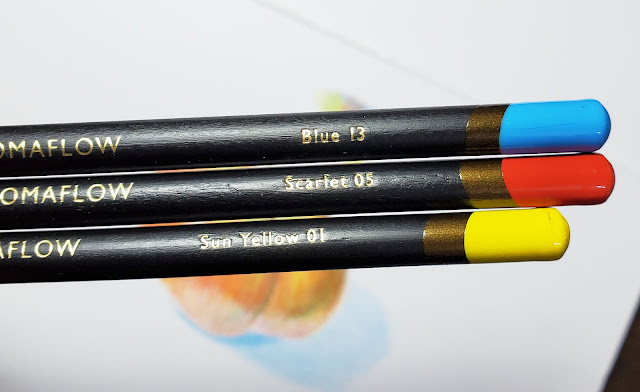 |
| Attractive, asymmetrical end caps that are Derwent's trademark |
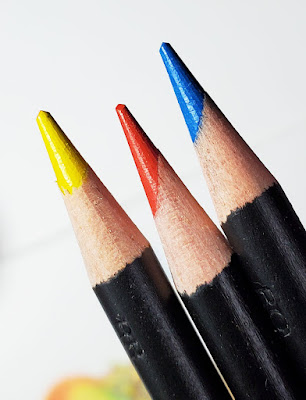 |
| Two out of three of my triad pencils have off-center cores. |
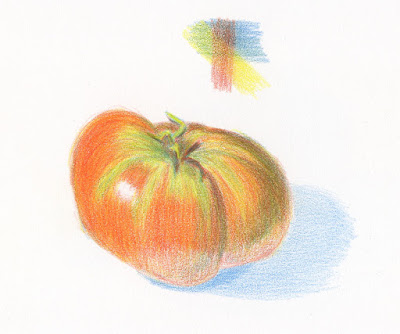 |
| 10/13/21 Derwent Chromaflow pencils in Stillman & Birn Zeta sketchbook |
The new pencils are on the harder side, but as a big fan of Faber-Castell Polychromos, I don’t hold anything against a hard colored pencil if it is richly pigmented. Unfortunately, these pencils do not seem to be, but I keep going with my sketch.
Using light pressure, I apply a few layers of pigment. I start to notice that it’s becoming more and more difficult to see that additional pigment is transferring from pencil to paper. I remain patient as long as possible, trying to apply more layers. Now I’m getting frustrated, so I start to press harder, which doesn’t help. I’m using my favorite Stillman & Birn Zeta sketchbook, whose smooth surface typically takes hard colored pencils beautifully, but now I’m getting angry because I feel like I’m drawing on waxed paper.
Three-quarters of an hour later, I stop – I’ve had enough. I admit, sometimes I enjoy the challenge of fighting with a difficult pencil, but this wasn’t one of those times. Now you might look at this sketch and think, “Well, she eked out some decent color there . . . maybe those pencils aren’t so bad.” But I had to work dang hard to get even what you see there.
That is what it’s like to use a low-quality colored pencil with low pigment content.
Whoa, Tina – that’s harsh! And this made-in-Britain Chromaflow set is from Derwent, a highly reputable UK colored pencil maker!
But that’s just it: These are not Crayola or Rose Art pencils (and they certainly aren’t priced like those kids’ pencils: My set of 12 Chromaflow was $14.99 at Blick). I know that Derwent makes some very fine colored pencils. In fact, I am currently having a love fest with Derwent’s artist-quality Lightfast line, and I have long appreciated the company’s Drawing Pencil collection for life drawing, so I know they make high quality products. (Derwent’s low-end Artist and Studio pencils are more in line with Chromaflow’s quality, and those I do not love.)
That brings up another matter: How many low-end, low-quality colored pencil lines does one manufacturer need? And now a new one just for the US market!
I try to find one positive thing to say about any product I review. In this case, I love the drawing of the parrot on the tin. But I’m certain it wasn’t made with Chromaflow pencils.
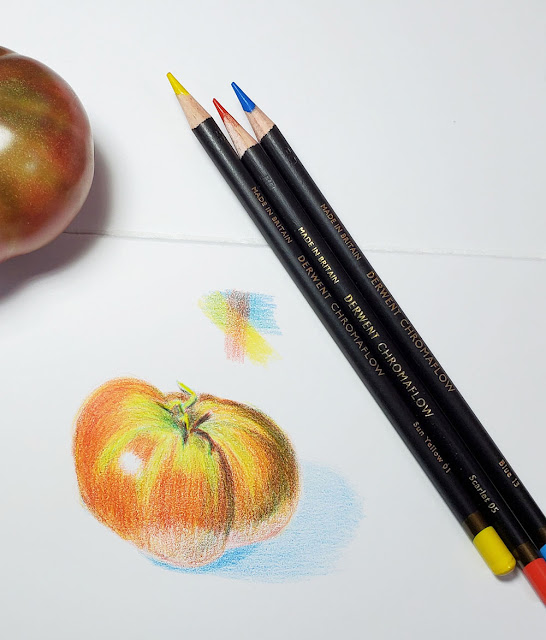 |
| Save your money. |

Sorry they don't have a lot of pigment like you love!
ReplyDeleteThanks for your informative review! It is sad that a reputable company like Derwent would even consider producing a product that is so inferior. And you know there will be many, many unwary US artists who will spend their precious coin for this US Only product thinking it is something special.
ReplyDeleteIt is sad, indeed, especially when we know they can make excellent products, too. And these aren't even cheap!
DeleteI'm a Prismacolor 150 girl myself, but looking to expand my rainbow a bit when an ad for the Chromaflow caught my eye…wow am I happy I found your review on them first! Thank you!
ReplyDeleteYour newest faithful follower,
Shelly
Glad you found the review helpful! I don't know of any set that would expand on your set of Prismacolor 150! However, Derwent Lightfast, which are very soft (though they feel different from Prismacolor because they are oil-based instead of wax-based), has some unusual earthy tones that may be unique.
DeleteG'day Tina- wow okay. Would you buy again from your local Derwent homepage for a more recently made set of primaries ? I actually love them but then they weren't available here for ages (as art here is taught with Artists or Polychromos in primary schools, my attitude to pencils for ages after was... yuck) I held off for quite a while.
ReplyDeleteI got the 24 pack which has a couple differences to yours but still says "for USA only" heh... but the tin size/selection of colours was great for streetscape scribbles. (Happily lend them to strange kids in cafes and don't care if I drop the pencils or tin... compared to my kit's gear Drawing or other pencil types!) Blends on even trash paper, receipts or the back of that slippery postcard card-stuff were easy. Another whole tin was the only way to find extras- a few dodgy pencils too. Upgraded to the 72 pack via a UK Amazon purchase (couple dodgy) and recently got the 150 set as I can finally get singles here. They all blend the same- mostly really well- as the first 24 pack I got but am not finished in the 150 pack yet. I got a badly off-centred core and a badly bent one just in the top 50 tray I swatched! (Yes I'll be complaining to the retailer so I get what I paid for, when I get through the entire tin.)
I'm glad to hear you are enjoying your Chromaflows (at least the ones that aren't bent or off-center)! I really love Derwent Lightfast and Inktense pencils, and the Drawing (colored) line is a big favorite. But all the rest of the Derwents I can do without... which is a good thing, since they are all over-priced in the US! Even those "for USA only" Chromaflows!
DeleteIt seems the Chromaflow you got was a bad batch. My own Chromaflow set is not hard and their softness is comparable to Prismacolour and Derwent Lightfast, and has better pigment load than Derwent Artist. The pigment load definitely not as good as Derwent 's Lightfast series which may need to thin down the saturation by the blender!
ReplyDeleteI once did received a Derwent coloursoft orange red that was hard as stone and hardy got any pigment load and sent back the local distributor report to Derwent.
Hmmm, well, if I did get some from a bad batch, it explains why others are raving about these pencils. I have too many pencils I love right off the bat to worry about these. ;-)
DeleteI'm very surprised by your review, as Chromaflows are some of my favorite pencils (and I also use Polychromos and Luminances, so I have a comparison). A few years ago, I bought four of them, then a pack of 24, then a few more. The pencils from my pack are very highly pigmented (even though not as highly as the Luminances, but that can be said about almost all other brands), many of the colors have good lightfastness and they draw extremely smoothly in multiple layers on all kinds of paper. They don't even require a blender most of the time - the colors mix beautifully, it feels almost like magic. The leads are reasonably well-centered (although I know that Derwent often has problems with this, requiring the use of some sharpening tricks) and none of the pencils are bent. For me, they are perfect for sketching. If I didn't have so many other colored pencils, I'd buy the biggest set of 150 Chromaflows. Maybe I'll do it anyway one day. So I agree with the previous comment that you must have gotten a particularly bad batch, which is a shame. It seems that the Derwent company were having some serious issues with quality control at that time, I hope they have improved it since then.
ReplyDeleteI'm glad you like yours! Who knows -- maybe I just got a bad set. I gave my set away, as I have so many other pencils I like better.
Delete